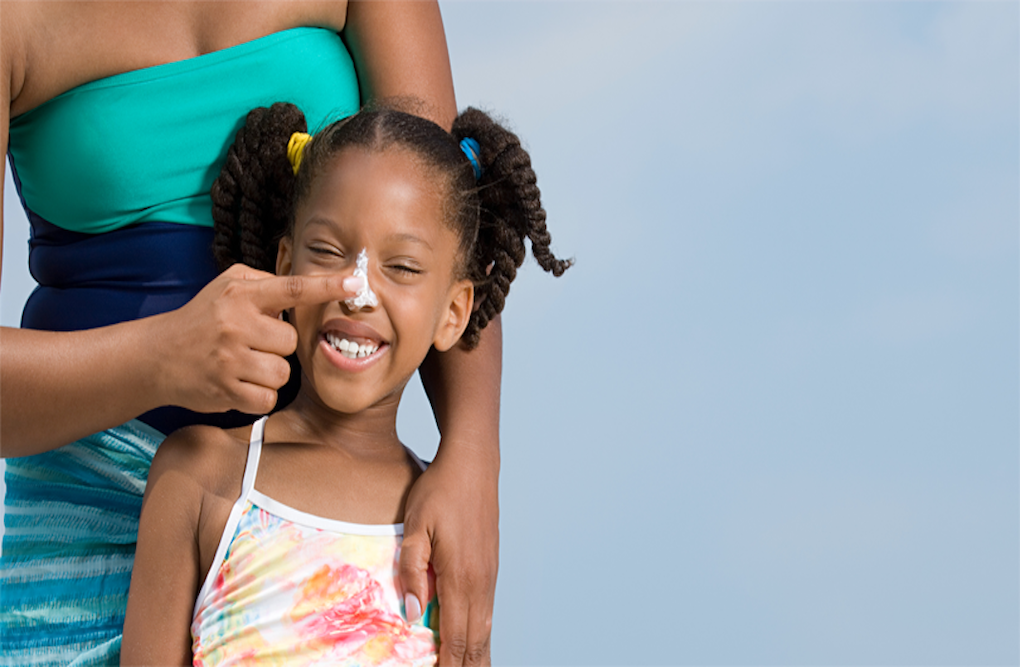Does anyone else feel like sunscreen got really complicated all of the sudden?! When we were kids, our parents would slap us with some drug store SPF 30 and call it a day. Now, this space is riddled with debates ranging from whether your baby needs all natural, mineral sunscreen to questioning if anything under SPF 15 even works. And what’s the deal with SPF 100? Keeping our littles safe from the sun is, of course, a high priority, so we’ve been determined to get to the bottom of this. We tapped our friends at Evereden, a skincare company that creates clean products for mom and babe, to get the low down. Here’s what you need to know.
When to Begin
Pediatrician and Mom Expert, Dr. Alison Mitzner, recommends avoiding sunscreen for the first six months of your baby’s life. During this phase, your mini’s skin is ultra-sensitive and not ready for much sun exposure. If you’re planning on taking them on a walk or spending some time outside, make sure to find a shady spot and provide them with some essentials like hats (what’s cuter than a bucket hat on your babe?), sunglasses, and sun-protective clothing. Once your mini passes the six month mark, sunscreen is officially your new mom purse staple. When it comes to your babe’s sunblock you have two options: chemical and mineral.
Chemical Sunscreen
*Top Tip: Apply 15 minutes before sun exposure to ensure absorption.
Chemical sunscreen works by absorbing into the skin and, in turn, absorbing the UV light from the sun and releasing it as heat after a chemical reaction takes place. When purchasing chemical sunscreen, it’s best to opt for “broad spectrum”—meaning it protects against both UVA and UVB rays. Make sure to look for SPF 15 or higher, anything less unfortunately won’t do much for your babe. Pro tip? Always remember to apply a THICK layer all over your babe’s bod 15 minutes before going outside. This lag time is crucial when using chemical sunscreens because they need to absorb into the skin in order to be effective.
Mineral Sunscreen
*Top Tip: Turn to this sunscreen first if you or your mini have sensitive skin types.
Mineral sunscreen, on the other hand, is sunscreen that is formulated with zinc oxide and titanium dioxide. You don’t have to apply it in advance because it works by sitting on top of the skin to protect from the sun and will start working as soon as you put it on. The active ingredients in mineral sunscreen provide UVA and UVB protection and are not chemicals, so they are great for children with sensitive skin as it won’t typically cause a reaction. Certain chemical sunscreens can trigger allergic reactions or contact dermatitis, according to Dr. Joyce Teng, Stanford’s Head of Pediatric Dermatology and Evereden’s Chief Scientific Officer. Dr. Teng tells us, “One common ingredient in chemical sunscreen, selenite, can very easily sensitize the kids,” so mineral sunscreen might be your best choice for sensitive skin. Another perk? Mineral sunscreen is reef-friendly—perfect for ocean swims!
What Works Best
*Top Tip: Read ingredient lists and make a judgement call (mama always knows best)!
When determining which is best for our babes, we turned to the experts. Pediatric Dermatologist who sits on Evereden’s Scientific Board, Dr. Sarina Elmariah says, “As a mom and dermatologist, I only recommend 100% physical sunscreens to all of my patients because they don’t contain any of the chemical sunscreens that can be absorbed into the bloodstream. Some mineral-based sunscreens are combined with chemical blockers, so I always say to read all of the ingredients and judge for yourself.” That means look out for mineral sunscreens with short ingredient lists, made up of zinc oxide and/or titanium dioxide plus natural ingredients.
The ABCs of SPF
Whether you choose to use chemical or mineral sunscreen, there are a few major rules to live by when it comes to sun exposure.
- Reapplication is a MUST. Reapply your babe’s ‘block every two hours and after they sweat or take a dip in the pool (basically anytime they get wet). Trust us, if anyone knows how hard it is to hunt down your babe for their third or fourth sunscreen application of the day, it’s us. But SO worth avoiding the painful sunburn!
- It’s best to avoid peak hours of sun exposure. From the hours of 10 AM to 2 PM, the UV index climbs dramatically, so we suggest bringing your babes outside to play in the mornings and late afternoons/evenings.
Any UV index above 5 is considered high sun exposure risk. So, be sure to check the UV index before venturing outside. Of course, we all want our littles to get that Vitamin D and sometimes that means sneaking in that midday walk or pool playtime. Luckily, you’re now armed with all the info you need to tackle those summer days with your babes!



